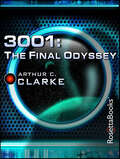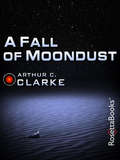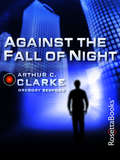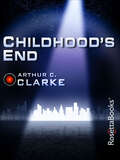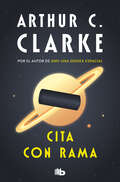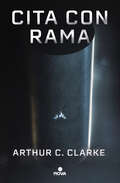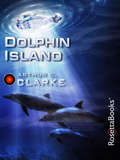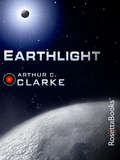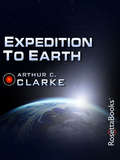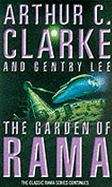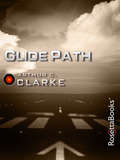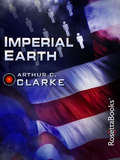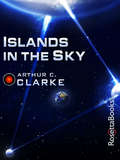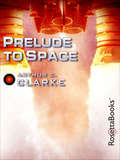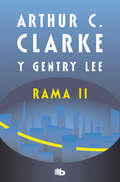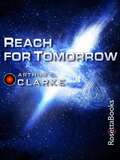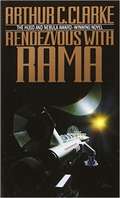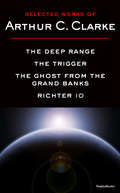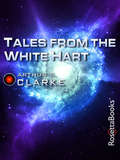- Table View
- List View
3001: The Final Odyssey (Space Odyssey Series #4)
by Arthur C. ClarkeThe mysteries of the monoliths are revealed in this inspired conclusion to the Hugo Award–winning Space Odyssey series—&“there are marvels aplenty&” (The New York Times). On an ill-fated mission to Jupiter in 2001, the mutinous supercomputer HAL sent crewmembers David Bowman and Frank Poole into the frozen void of space. Bowman&’s strange transformation into a Star Child is traced through the novels 2010 and 2061. But now, a thousand years after his death, Frank Poole is brought back to life—and thrust into a world far more technically advanced than the one he left behind. Poole discovers a world of human minds interfacing directly with computers, genetically engineered dinosaur servants, and massive space elevators built around the equator. He also discovers an impending threat to humanity lurking within the enigmatic monoliths. To fight it, Poole must join forces with Bowman and HAL, now fused into one corporeal consciousness—and the only being with the power to thwart the monoliths&’ mysterious creators. &“3001 is not just a page-turner, plugged in to the great icons of HAL and the monoliths, but a book of wisdom too, pithy and provocative.&” —New Scientist
A Fall of Moondust (Arthur C. Clarke Collection #No.49)
by Arthur C. ClarkeA &“superbly ingenious&” classic of space survival from the author of 2001: A Space Odyssey—one of science fiction&’s most influential grandmasters (Daily Express). Expanding the Moon&’s population hinges on building a thriving tourist industry. But when a prototype tourist craft called the Selene encounters a moonquake, the ship plummets under a vast body of liquid-fine moondust called the Sea of Thirst. While time runs out for the passengers and crew, rescuers find their resources stretched to the limit by the unpredictable conditions of the lunar environment. Nominated for the Hugo Award in 1963, this brilliantly imagined story of human ingenuity and survival is a tour-de-force of psychological suspense and sustained dramatic tension sure to appeal to fans of Andy Weir&’s The Martian. &“The best book yet about man&’s most dramatic journey, the most exciting science fiction novel for years.&” —Evening Standard &“Expertly told and cruelly exciting to the end.&” —The Sunday Times &“Extremely good . . . with some superbly ingenious and exciting new twists.&” —Daily Express
Against the Fall of Night (Golden Age Masterworks Ser.)
by Arthur C. ClarkeThe renowned science fiction author&’s landmark novel of the last human born on a far future world—and his quest for the truth about existence. Living in the ten-billion-year-old city of Diaspar, Alvin is the last child born of humanity, and he is intensely curious about the outside world. But according to the oldest histories kept by the city fathers, there is no outside world—it was destroyed by the Invaders millions of years ago. One day, Alvin finds a rock with an inscription seemingly meant for him: &“There is a better way. Give my greetings to the Keeper of the Records. Alaine of Lyndar.&” This cryptic message takes Alvin on a quest to discover humanity&’s true past—and its future. Originally published in the November 1948 issue of Startling Stories, Against the Fall of Night is a rich and intensely poetic vision of a distant future that&’s sure to delight fans of Clarke and science fiction as a genre. &“[Clarke is] one of the truly prophetic figures of the space age.&” —The New Yorker
Childhood's End (Arthur C. Clarke Collection #Vol. 6)
by Arthur C. ClarkeIn the Retro Hugo Award–nominated novel that inspired the Syfy miniseries, alien invaders bring peace to Earth—at a grave price: &“A first-rate tour de force&” (The New York Times). In the near future, enormous silver spaceships appear without warning over mankind&’s largest cities. They belong to the Overlords, an alien race far superior to humanity in technological development. Their purpose is to dominate Earth. Their demands, however, are surprisingly benevolent: end war, poverty, and cruelty. Their presence, rather than signaling the end of humanity, ushers in a golden age . . . or so it seems. Without conflict, human culture and progress stagnate. As the years pass, it becomes clear that the Overlords have a hidden agenda for the evolution of the human race that may not be as benevolent as it seems. &“Frighteningly logical, believable, and grimly prophetic . . . Clarke is a master.&” —Los Angeles Times
Cita con Rama (Serie Rama #Volumen 1)
by Arthur C. ClarkeHa pasado lo impensable: ¿será este el primer encuentro de la humanidad con inteligencia extraterrestre? Llega el momento de la cita. «Arthur C. Clarke expandirá tus horizontes». The Guardian Año 2130. Después del impacto de un enorme asteroide que destruye Padua y Verona, se crea en un sofisticado sistema de detectar la trayectoria de cualquier objeto que se detecte desde la Tierra De esta forma los astrónomos detectan un misterioso asteroide, al que bautizan como «Rama», que está a punto de cruzar el sistema solar. Se trata de un cilindro perfecto de unos cincuenta kilómetros de largo, que gira a una velocidad fuera de lo normal y viaja por el espacio en línea recta. Frente a esas evidencias, los investigadores se preguntan si ante ellos está el primer visitante procedente de las estrellas… ¿Podrá la humanidad enfrentarse al enigma que alberga esta extraña nave, aparentemente extraterrestre y que es ya una maravilla tecnológica que forma parte del imaginario de varias generaciones de lectores? Cita con Rama es una de las obras más premiadas de uno de los mejores escritores de ciencia ficción de todos los tiempos, galardonada con los premios Hugo, Nebula, Locus, John W. Campbell y BSFA. Sin duda una de las mejores novelas escritas por el autor.
Cita con Rama (ed. ilustrada)
by Arthur C. ClarkeLa edición ilustrada Del gran clásico de Arthur C. Clarke con 5 ilustraciones del artista Gabriel Björk Stiernström Año 2130. Los astrónomos detectan un misterioso asteroide, al que bautizan como «Rama», que está a punto de cruzar el sistema solar. Se trata de un cilindro perfecto de unos cincuenta kilómetros de largo, que gira a una velocidad fuera de lo normal y viaja por el espacio en línea recta. Ante esas evidencias, los investigadores se preguntan si están ante el primer visitante procedente de las estrellas... ¿Podrá la humanidad enfrentarse al enigma que alberga esta extraña nave, aparentemente extraterrestre, y que es ya una maravilla tecnológica que forma parte del imaginario de varias generaciones de lectores? Bienvenidos al gran clásico que Denis Villeneuve llevará al cine. Cita con Rama es una de las obras más premiadas de uno de los mejores escritores de ciencia ficción de todos los tiempos, galardonada con los premios Hugo, Nebula, Locus, John W. Campbell y BSFA.«Arthur C. Clarke expandirá tus horizontes».The Guardian
Dolphin Island (Arthur C. Clarke Collection)
by Arthur C. ClarkeA science fiction adventure for readers of all ages, from a winner of multiple Nebula and Hugo Awards. In the near future, a cargo hovership makes an emergency landing in a rural part of the Midwest. An adventurous teenager, Johnny Clinton sneaks on board—only to survive a second crash a few hours later, this time into the Pacific Ocean . . . The crew escapes, but Johnny is left on board, adrift in the wreckage of the ship—until he is rescued by a pod of dolphins, who bring him to a remote island hidden in the heart of Australia&’s Great Barrier Reef. There, Johnny meets the brilliant and eccentric Professor Kazan, who has dedicated his life to the study of dolphin communication. Here in this new world, Johnny will find his courage tested once again . . .
Earthlight: An Omnibus Containing The Complete Novels Of Childhood's End And Earthlight And Eighteen Short Stories (Arthur C. Clarke Collection)
by Arthur C. ClarkeThis &“marvelous lunar espionage thriller&” by the science fiction grandmaster and author of 2001: A Space Odyssey &“packs plenty of punch&” (SFReviews.net). Two hundred years after landing on the Moon, mankind has moved further out into the solar system. With permanent settlements now established on the Moon, Venus, and Mars, the inhabitants of these colonies have formed a political alliance called the Federation. On the Moon, a government agent from Earth is tracking a suspected spy at a prominent observatory. His mission is complicated by the rise in tensions between Earth&’s government and the Federation over access to rare heavy metals. As the agent finds himself locked in a battle for life and death on the eerie, lunar landscape, the larger conflict explodes across space, leaving mankind&’s future in doubt. First published in 1955, this suspense-filled space opera by the Science Fiction and Fantasy Hall of Fame inductee was a significant forerunner of television hits like Star Trek and The Expanse.
Expedition to Earth (Arthur C. Clarke Collection)
by Arthur C. ClarkeShort stories from the science fiction master—including the tale that inspired 2001: A Space Odyssey. These stories present a brilliant showcase of Arthur C. Clarke&’s many-layered approach to the moral dilemmas of scientific advancement—from the thrilling and brutal &“Breaking Strain&” to the more poetic and thoughtful &“Second Dawn.&” Also included is &“The Sentinel&”—the basis for the classic Stanley Kubrick film 2001: A Space Odyssey. This outstanding collection reminds us that the author of Childhood&’s End was not only a giant in the world of science fiction, a recipient of multiple Nebula and Hugo Awards, and an incomparable storyteller, but also a &“skilled literary artist&” (Hartford Courant). &“I do not know of any short story that has moved me more than Arthur C. Clarke&’s &‘If I Forget Thee, Oh Earth.&’&” —The Christian Science Monitor
Garden of Rama
by Arthur C. ClarkeThe Ramans return in the third saga of extraterrestrial contact--a riveting odyssey of a future Eden. The phenomenon begun in Rendezvous with Rama and carried on in Rama II continues in a masterpiece of technological extrapolation--an exhilarating adventure into the heart of both the universe and humankind. Arthur C. Clarke is without question the world's best-known and bestselling science fiction writer. He was born in Minehead, Somerset; the town recently hosted a Festival of Space in honour of his seventy-fifth birthday. He has won innumerable international awards for his fiction, for his scientific writing, and for his inspirational role as one of the chief prophets of the space age. His collaboration with Stanley Kubrick on 2001: A Space Odyssey set new standards for SF films. As the presenter of the TV series Arthur C. Clarke's Mysterious World and its successors, Clarke has become a household name. He lives in Sri Lanka. Gentry Lee combines two remarkable careers; on the one hand he is a screenwriter, whose credits include Carl Sagan's Cosmos series; on the other he is a distinguished space scientist, being chief scientist on NASA's' deep space exploration programme. His collaboration with Arthur C. Clarke was born when he was assigned by Warner Brothers to script the film of Cradle from Clarke's extensive treatment.
Glide Path: To The Heart Of Experimental Techologywwii (Arthur C. Clarke Collection)
by Arthur C. ClarkeA gripping novel of human ingenuity during World War II, based on the visionary author&’s own wartime experiences as a radar control operator. One of the most influential science fiction writers of the twentieth century, Arthur C. Clarke has consistently anticipated the actual achievements of science and technology. In Glide Path, he turns back the clock to tell a thrilling story about the groundbreaking exploration of radar during WWII. Clarke&’s only non–science fiction novel shines with the same qualities that made his award-winning space adventures timeless classics: topnotch suspense, fascinating science, and memorable characters. A hidden gem in Clarke&’s impressive body of work, Glide Path is an enthralling read for both science fiction fans and history aficionados.
Imperial Earth
by Arthur C. ClarkeA futuristic tale of intergalactic love and politics from the legendary &“colossus of science fiction&” and creator of 2001: A Space Odyssey (The New Yorker). In the year 2276, Duncan Makenzie travels from Saturn&’s moon, Titan, to Earth as a diplomatic guest at the United States&’ Quincentennial. As a member of Titan&’s &‘First Family&’ descended from the moon&’s original settlers five hundred years before, Duncan finds himself welcomed back to Mother Earth and into Washington&’s glittering political and social scene. But Duncan isn&’t just on Earth for ambassadorial reasons. Haunted by the memory of a woman from Earth he once loved, Duncan is also on a mission to continue his family line . . . despite a devastating genetic defect. A tour-de-force of vivid characterization, futuristic vision, and suspense, Imperial Earth is one of Arthur C. Clarke&’s most ambitious and thought-provoking novels. &“Clarke at the height of his powers.&” —The New York Times
Islands in the Sky
by Arthur C. ClarkeThe technologically groundbreaking novel of space exploration from the only science fiction author nominated for a Nobel Peace Prize. Roy Malcolm has always been fascinated by space travel. And when he wins a voyage to the Inner Space Station as a game show prize, he&’s sure it&’s the trip of a lifetime. Before long, Roy is taken in by the young crew—and shares their adventures and lives. One of Arthur C. Clarke&’s earliest novels, Islands in the Sky is particularly noteworthy for its description of geostationary communications satellites. While this technology was nonexistent during the writing of this book, it later became commonplace—and Clarke is credited with the first practical descriptions of such technology. This book is compelling not just as a fictional tale, but as an example of the prescient power of Clarke&’s vision. &“[Clarke is] one of the truly prophetic figures of the space age.&” —The New Yorker
Prelude to Mars
by Arthur C. Clarke2 complete novels - Prelude to Space, and The Sands of Mars - and 16 short stories by the sci-fi master
Prelude to Space
by Arthur C. ClarkeAn uncannily prophetic novel of early space exploration from the legendary &“colossus of science fiction&” and creator of 2001: A Space Odyssey (The New Yorker). The world&’s first lunar spacecraft is about to launch. The ship, Prometheus, is built from two components—one designed to travel trough outter space to the Moon and back, and the other to carry the first component through Earth&’s atmosphere and into orbit. Dirk Alexson, a historian assigned to documenting the project, travels from London to the desert base in Australia where Prometheus is to be launched. In a true example of life imitating art, Alexson describes what would become the foundation for the actual space shuttle program twenty years later. First published in 1951, Prelude to Space is full of detailed technical descriptions and conversations regarding the possibility of spaceflight, many of which mirrored—or were actually cited in—the construction of the first spaceships and telecommunications satellites. Clarke&’s uncanny ability to predict so many events, concerns, dilemmas, and triumphs of space exploration decades in advance make this fascinating novel as much science as it is fiction.
Rama II (Serie Rama #Volumen 2)
by Arthur C. ClarkeLa secuela de la única novela de ciencia ficción que arrasó con todos los premios del género y una de las más vendidas de todos los tiempos. «Arthur C. Clarke es uno de los mayores genios existentes». Ray Bradbury En 2130, una nave extraterrestre, Rama, entró en nuestro sistema solar. El primer producto de una civilización extraterrestre que encontró el ser humano reveló muchas maravillas, pero con su partida, la mayoría de sus misterios permanecieron sin resolver.Sesenta y seis años después de que la primera nave Rama atravesara el sistema solar, se avista una segunda nave. Pero esta vez, la Tierra está lista para ella: sabiendo qué esperar, los habitantes del planeta se preparan para montar una expedición que pueda resolver, por fin, algunas de las preguntas que la primera Rama dejó en el aire. Pero la tripulación no está preparada para lo que les espera dentro de la nave, y tampoco para los conflictos que estallan entre la gente... Vuelve el misterio. Vuelve el mayor acontecimiento para el ser humano. Vuelve Rama.
Reach for Tomorrow
by Arthur C. ClarkeThis collection of short stories brings numerous lesser-known works from the world's foremost master of science fiction together for the first time. Reach for Tomorrow includes twelve highly memorable stories. Included is "Rescue Party," a short story that may have served as an origin story for the renowned Rama series. As a cross-section of Clarke's work, Reach For Tomorrow is astonishingly diverse. Readers will find tales ranging in scope from the time of the dinosaurs to the unimaginably distant future; locations as far-flung as distant galaxies and as close as London; and voyages to the center of the earth and beyond the stars. It's a fun and fascinating read for any fan of Clarke or science fiction in general.
Rendezvous with Rama (Rama #1)
by Arthur C. ClarkeAstronauts explore an alien spacecraft hurtling toward the sun in this Hugo and Nebula Award–winning novel—&“a stone-cold classic&” of hard sci-fi (The Guardian). An enormous cylindrical object has entered Earth&’s solar system on a collision course with the sun. A team of astronauts are sent to explore the mysterious craft, which the denizens of the solar system name Rama. What they find is astonishing evidence of a civilization far more advanced than ours. They find an interior stretching over fifty kilometers; a forbidding cylindrical sea; mysterious and inaccessible buildings; and strange machine-animal hybrids, or &“biots,&” that inhabit the ship. But what they don&’t find is an alien presence. So who—and where—are the Ramans? Often listed as one of Clarke&’s finest novels, Rendezvous with Rama won numerous awards, including the Hugo, the Nebula, the Jupiter, and the British Science Fiction Awards. A fast-paced and compelling story of an enigmatic encounter with alien technology, Rendezvous with Rama offers both answers and unsolved mysteries that will continue to fascinate readers for generations. &“Mr. Clarke is splendid . . . We experience that chilling touch of the alien, the not-quite-knowable, that distinguishes SF at its most technically imaginative.&” —The New York Times
Selected Works of Arthur C. Clarke: The Deep Range, The Trigger, The Ghost from the Grand Banks, Richter IO
by Arthur C. ClarkeA collection of four unique science fiction novels by the innovative, award-winning author of 2001: A Space Odyssey. This collection not only thrills and excites readers with Clarke&’s passion for science fiction and speculative work, but his words ask readers big questions about what it means to be human, and humanity&’s relationship with nature and technology.The Deep Range: A hundred years into the future, humanity lives mostly on the oceans, tending vast whale herds and plankton farms. Walter Franklin works on a submarine patrol, and his adventures under the sea are told in this riveting tale, set against the backdrop of a world both futuristic and familiar.The Trigger: A team of scientists develops the ultimate passive weapon, a device that detonates all nitrate-based bombs. But even protective weaponry comes with moral dilemmas, and the device&’s inventor struggles to keep the weapon from those with violent intentions.The Ghost from the Grand Banks: An astonishing discovery is made when the two halves of the Titanic are raised from the seabed, six perfectly preserved bodies, including a beautiful woman who was not listed among the ship&’s original passengers. The mission to discover her secret becomes obsessive, and dangerous.Richter 10: A violent earthquake killed Lewis Crane&’s parents when he was just a child. Now grown up, he has devoted his life to protecting humankind from earthquakes. A renowned scientist, Crane has developed technology to fuse the Earth&’s tectonic plates to stop earthquakes forever, but what repercussions will this have on the planet?
Tales From Planet Earth
by Arthur C. ClarkeFourteen classic hard science fiction stories by a master of the genre.
Tales from the White Hart (El\libro De Bolsillo Ser.)
by Arthur C. ClarkeA compendium of science fiction stories filled with &“high diversion, amusement and amazement&” from the legendary creator of 2001: A Space Odyssey (Los Angeles Times). In the White Hart Pub in London just north of Fleet Street, Harry Purvis holds court with his fellow writers of scientific yarns. A consummate storyteller, Harry is joined by the actual writers Samuel Youd, John Wyndham, and Clarke himself, all under pseudonyms, and all trying to outdo each other with their outlandish tales of science and invention. Inspired by the Jorkens collections by Lord Dunsany, this anthology combines elements of comedy and horror, with &“sly wit and inviting prose style&” and a distinctly English flavor (AV Club). Written by a &“collossus of science fiction,&” Tales from the White Hart is not just for fans of the genre, but for anyone who appreciates a good tall tale (The New Yorker). &“One of the most astounding imaginations ever encountered in print.&” —The New York Times
Tales of Ten Worlds
by Arthur C. ClarkeTen short science fiction stories by one of the grand masters of the field, including: I Remember Babylon, Summertime on Icarus, Out of the Cradle Endlessly Orbiting, Who's there?, Hate, Into the Comet, An Ape About the House, Saturn Rising, Let There Be Light, Death and the Senator, Trouble with Time, Before Eden, A Slight Case of Sunstroke, Dog Star, and The Road to the Sea.
The Challenge of the Spaceship
by Arthur C. ClarkeThe last quarter of this century will be an age of exploration such as Man has never seen before. Astronomy and physics will be the fields of knowledge most immediately affected. Yet the first direct results of astronautics may be less important in the long run than the indirect consequences. With the expansion of the world's mental horizons may come one of the greatest outbursts of creative activity ever known. <p><p> In THE CHALLENGE OF THE SPACESHIP Arthur C. Clarke speculates on the changes that will come in our own generation — the first generation to break away from the limitations of our own planet — and predicts some of the astonishing scientific developments that will inevitably come in future centuries. Among these will be manned spaceships traveling at speeds of more than 1,000,000 m.p.h., techniques for changing and controlling the climate of the entire earth, exploration of an area ten times greater than all our continents on the other planets of the Solar System, and discovery of the basic secrets of life and synthesis of living matter in the laboratory.
The City and the Stars (Arthur C. Clarke Collection)
by Arthur C. ClarkeThis grand space adventure explores the fate of humanity a billion years in the future— A visionary classic by one of science fiction&’s greatest minds. Far in the future, Earth&’s oceans have evaporated and humanity has all but vanished. The inhabitants of Diaspar believe their domed city is all that remains of an empire that had once conquered the stars. Inside the dome, the citizens live in technological splendor, free from the distractions of aging and disease. Everything is controlled precisely, just as the city&’s designers had intended. But a boy named Alvin, unlike his fellow humans, shows an insatiable—and dangerous—curiosity about the world outside the dome. His questions will send him on a quest to discover the truth about the city and humanity&’s history—as well as its future. A masterful and awe-inspiring work of imagination, The City and the Stars is considered one of Arthur C. Clarke&’s finest novels.
